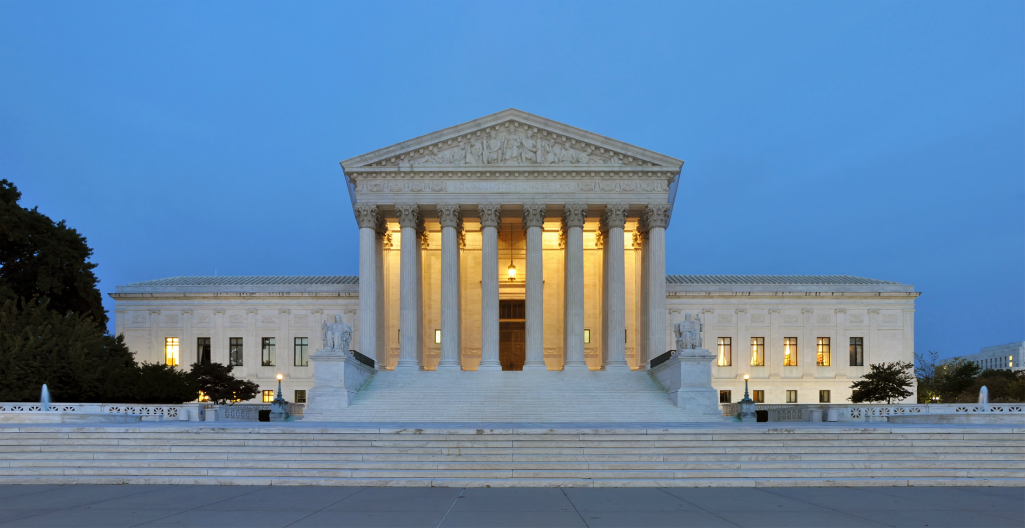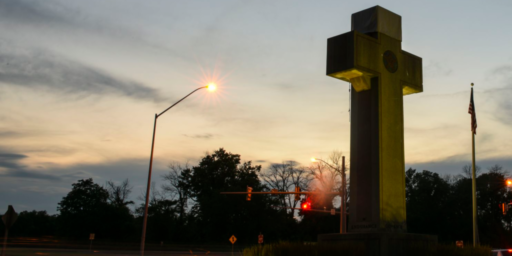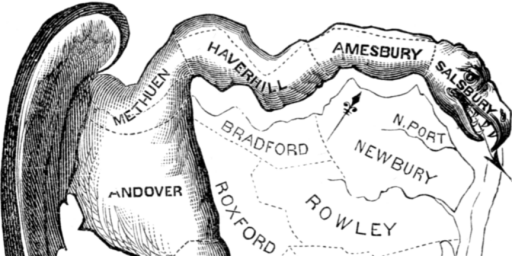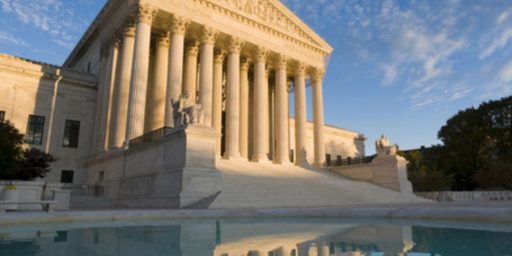Previewing A Busy June At The Supreme Court
Starting tomorrow, we should be getting some headline-grabbing opinions from the Supreme Court.

It’s the beginning of June, which means it’s time for another countdown to the end of the Supreme Court’s current term. While this term has lacked many of the blockbuster cases that we’ve seen in the past, there are nonetheless several important decisions awaiting an opinion, meaning that this will once again be an interesting month at One First Street:
The Supreme Court is entering the final rounds of a term featuring a newly solidified conservative majority that has faced off at times against the four liberal justices and seen some dramatic moments.
]So far, Chief Justice John Roberts has bobbed and weaved, balancing his institutional concerns against his own solidly conservative leanings. Justice Brett Kavanaugh joined the court in the early part of the 2018-19 term after a contentious nomination hearing featuring allegations of sexual misconduct as a teenager. Justice Ruth Bader Ginsburg had two cancerous nodules removed from her left lung in December.
There have been some opinions that resemble compromises.
Neither Elena Kagan nor Stephen Breyer publicly dissented when the court issued an unsigned opinion allowing one provision of an Indiana law go into effect that mandated the burial or cremation of fetal remains. On the same day, the justices left in place a lower court ruling that invalidated a much more restrictive abortion related provision of the same law. Justice Clarence Thomas, kept up the pressure from the right side of the bench reminding his colleagues of his view that “the Constitution itself is silent on abortion.”
The justices have met week after week and extended courtesies on the bench such as Thomas silently offering a hand to Ginsburg as she leaves the courtroom, but they’ve also feuded late into the night on death penalty petitions.
As the term ends the country will see where they stand on a citizenship question on the 2020 census, as well as the issue of extreme partisan gerrymandering. And all eyes will look to next term — held in the heat of the election—to see which cases the court will decide to hear.
Here’s a recap of the outstanding “high profile” cases that we will see opinions on in the weeks to come:
Department of Commerce v. New York et al (See Update below)
This is the case challenging the Trump Administration’s decision to put a question on the 2020 Census Form asking for citizenship information for each of the people living in a surveyed household. In the Courts below, the District Court Judge ruled in favor of the Plaintiff states that the Commerce Department had acted improperly in placing the question on the form, relying in no small part on evidence such as comments made by Commerce Secretary Wilbur Ross regarding the real reason the question was being placed on the ballot. Rather than taking the matter to the Second Circuit Court of Appeals, the Trump Administration took the atypical route of a direct appeal of the District Court decision to the Supreme Court, something that is rarely granted. This time, though, the gamble paid off since the Court accepted the case for review, thus significantly increasing the pace of the case through the Federal Court system. After that happened, a second Federal Judge in California issued a ruling against including the question on the Census, but that decision remains on hold pending the Court’s decision in this case. During oral argument of the case in April, though, it appeared as if there was a majority of Justices inclined to reverse the holdings below and rule in favor of the Trump Administration.
More recently, the case has returned to the news cycle due to the fact that there appears to be new evidence regarding the motivation for including the question on the questionnaire Specifically, this evidence consists of a study conducted by a Republican political consultant who has since died that argued that including the citizenship question would likely discourage Latinos from filling out the census form, thus decreasing the count in states with high Latino populations. The study also argued that this stood to benefit Republicans because it would impact reapportionment of Congressional seats after the Census. All of this was apparently discovered just recently by the consultants family as they went through his papers and records.
Ordinarily, an appeals court such as the Supreme Court does not consider evidence that wasn’t presented at trial and isn’t part of the record in the case. Additionally, there is no procedure for a situation such as this when the evidence in question was clearly previously unknown to the Plaintiffs. The Plaintiffs have apparently filed the appropriate paperwork with both the District Court Judge that issued the initial opinion in the case and the Supreme Court setting forth the new evidence. Potentially, the Court could remand the case to the District Court for consideration of this new evidence and supplementation of the record, but they are not required to do so and could instead decide to rule based solely on what was presented to them up to the point that oral argument concluded.
Update: On June 27th ruled largely in favor of the parties challenging the inclusion of the citizenship question and held that
Rucho v. Common Cause and Lamone v. Besniak (See Update)
These two cases both deal with allegations that states legislatures unfairly drew Congressional district lines to benefit one party over the other. The Rucho case deals with the Congressional Districts in North Carolina, which a three-judge panel of Federal District Court Judges had found were unfairly drawn in a manner that overwhelmingly benefited the Republican Party. The Lamone case, meanwhile, deals with Congressional Districts in Maryland and the allegation that a single district in the western part of the state was redrawn in a manner that diluted the voting power of the largely Republican counties in western Maryland by shifting the boundaries eastward into parts of the suburbs of Washington, D.C. that are dominated by Democrats.
This is the second time that the Lamone case has been before the Supreme Court. The first time was just last year when it was paired with a case out of Wisconsin that raised many of the same issues that the Rucho case does. When oral argument was heard in both cases, though, it was clear that the Justices were divided on the issue and unsure about the implications of issuing the kind of landmark rulings that the Plaintiffs in both cases were hoping for. Many speculated at the time that the fate of the two cases would depend on where former Associate Justice Anthony Kennedy stood on the cases. In the end, though, the Court ended up issuing unanimous rulings that punted the cases on procedural issues rather than getting to the substantive legal issues raised by them. In one case, Gil v. Whitford, the Court held that the Plaintiffs in the case had failed to demonstrate that they had legal standing to challenge the entire redistricting map in Wisconsin. In the second case, Benisek et al v. Lamone et al., the Justices ruled that the Plaintiffs in the case had failed to demonstrate the grounds necessary to receive a Preliminary Injunction from the District Court to prevent elections in Maryland’s Sixth Congressional District based on the 2011 map. Both cases were remanded back to the relevant District Court for further proceedings. .
When the Justices heard oral argument on these cases in late March it was once again apparent that the Justices were divided, in no small part because there doesn’t appear to be an easy way to establish a legal rule regarding when a particular district or districts was “too partisan” in favor of one party or the other. This time around, though, it will be harder for the COurt to avoid issuing some kind of substantive ruling on the issue of partisan gerrymandering. Whatever they do decide will likely have a huge impact on how states approach redistricting in the wake of the 2020 Census.
Update: In a 5-4 decision, the Supreme Court ruled that cases raising arguments of partisan gerrymandering are political questions that Federal Courts cannot decide.
Virginia House of Delegates v. Bethune Hill (See Update)
CNN Supreme Court reporter Ariane de Vogue summarizes the issues in this case dealing with racial gerrymandering:
The court is looking at 11 districts drawn by the Republican-led legislature in Virginia in 2011 that were struck down as an unconstitutional racial gerrymander by the lower court.
Registered voters in each district challenged the maps and prevailed below when a lower court held that they had “shown through telling direct and circumstantial evidence that race predominated over traditional districting factors.”
Lawyers for Virginia’s House of Delegates are seeking to represent the state over the objections of the Democratic governor and attorney general and they are asking the Supreme Court to reverse the lower court. They say the maps were drawn to comply with the Voting Rights Act.
Lawyers for Virginia’s House of Delegates are seeking to represent the state over the objections of the Democratic governor and attorney general and they are asking the Supreme Court to reverse the lower court. They say the maps were drawn to comply with the Voting Rights Act.
Update: On June 17th, the Supreme Court dismissed the appeal of the Virginia House of Delegates on standing grounds but did not rule on the merits of the case.
American Legion et al v. American Humanist Association (See Update)
This case is a First Amendment Establishment Cause case dealing with a cross that has been in place in a Maryland suburb of the District of Columbia since shortly after the First World War. It now stands at an intersection on a heavily traveled local road. The cross serves as a memorial to men from the community who died in the war and their names are carved into the memorial. The Plaintiff in the case, the American Humanist Association argued that keeping the cross on public property, along with the fact that the grounds on which it sits are maintained by public employees, constitutes a violation of the Establishment Clause of the First Amendment, an argument that a divided three-judge panel of the Fourth Circuit Court of Appeals agreed with in a ruling that overruled the decision of a Federal District Court Judge that ruled in favor of the government. In that decision, a majority of the panel ruled that the cross was an explicitly religious symbol and that it was improper for the county government to keep the cross in the location where it had been since roughly the 1920s.
As I explained in the posts where I’ve discussed this case (see here and here), though, there is a solid argument based on existing Supreme Court precedent that this cross represented the kind of de minimis breach of the wall of separation between Church and State that is represented by things such as placing “In God We Trust” on coin s and currency and opening legislative sessions with generic prayers, both of which have been upheld against legal challenges by the Supreme Court and other Federal Courts. The Justices appeared to agree with that argument when it heard oral argument in the case with even several of the court’s liberal Justices skeptical of the standard that attorneys for the Plaintiffs asserted should apply in a case like this. Because of that, we could see something close to a unanimous decision in this case.
Update: On June 20th, a 7-2 court ruled that the cross can stay in place.
Gamble v. United States (See Update below)
This deals with a century-old exception to the Double Jeopardy Clause of the Fifth Amendment which, at least by its plain terms, provides that no person can be tried twice for the same offense. This means, for example, that a prosecutor cannot obtain an indictment for murder against a person and if they fail to convict on that charge, turn around and reindict the same person for manslaughter or some other form of homicide. It also limits the extent to which a prosecutor can bring multiple unrelated charges against the same Defendant after they’ve been acquitted of the underlying offense. There are exceptions to the rule, but they are generally limited and extremely hard for prosecutors to obtain absent compelling evidence, such as evidence of a fraud on the court such as jury tampering or some other action that essentially made the first trial a fraud, or in a case where the trial ends with a mistrial due to a hung jury.
This case deals with what is probably the most controversial exception to the rule, the one that allows a defendant to be tried for the same offense in state and Federal Court even after having been acquitted in one jurisdiction or the other. This rule was established by the Supreme Court in a 1959 case called Abbate v. United States 359 U.S. 187 (1959), although it was actually first stated by the Court 37 years earlier in a case called United States v. Lanza 260 U.S. 377 (1922). In Lanza, a case which arose during the Prohibition era, a Defendant was prosecuted and convicted of making, transporting, and selling intoxicating liquors in violation of Washington state law. He was subsequently charged with violating the National Prohibition Act under the same set of facts. The Supreme Court ruled in that case that this subsequent Federal prosecution did not violate the Double Jeopardy clause essentially because the states and the Federal Government are separate entities and that prosecution by one does not rule out prosecution based on the same set of facts by the second. In Abbate, the Defendant was “part of [a] conspiracy to blow up multiple facilities owned by the Southern Bell Telephone Company. He was convicted in Illinois under a state law making it a crime to conspire to destroy the property of another and sentenced to three months of imprisonment. Thereafter, Abbate was indicted in [a] federal district court for a violation of federal law stemming from the same conspiracy.” (Source) Abbate’s attorney asked the Court to reconsider the ruling in Lanza that had established the dual sovereign doctrine, but the Court declined to do so.
Based on past comments in cases where this “dual sovereigns” issue was a tangential issue not relevant to the outcome of the case, it appeared that there were at least some Justices inclined to reconsider the nearly century-old exception, including both Clarence Thomas and Ruth Bader Ginsburg who are respectively the most conservative and most liberal of the Justices on the court. Despite that, oral argument in the case appeared to present us with a court where the majority of the Justices were inclined to let the doctrine stand, in at least some part based on the doctrine of stare decisis.
The sole issue here is whether or not the separate sovereigns doctrine should be overturned completely. Based on the reactions of several of the Justices during oral argument, it would appear that there isn’t a sufficient appetite on the Court to go that far.
Update: On June 17th, the Supreme Court handed down a 7-2 decision upholding the “dual sovereigns” exception. My analysis is here and Amy Howe’s analysis at SCOTUSBlog is also worth reading.
In any case, the fun begins tomorrow morning at 10:00 a.m. If you’re so inclined, the people at SCOTUSBlog will be live-blogging all the opinion days through the end of the term and, of course, we’ll be covering them here at OTB as well.




This is one to watch. What makes this particularly interesting is that there’s a strong argument that this evidence suggests that some of the underlying testimony in this case was proven to be false.
On the one hand, this would give the court cover to kick this back to the lower courts, but the reality is they are eventually going to have to decide this one, so I suspect they won’t take that action.
All that said, based on oral arguments and the recent trends of decisions from the court, I honestly don’t think the race issue here will sway the current conservative majority. They have repeatedly shown deference to the powers invested in a given office and I think their reasoning is that even if the action is ultimately tied to racist goals, the Commerce Department has the power to make that decision.
Nothing “high profile” today but the Allina decision is mildly interesting in terms of a potential impact on the census and DACA cases from the APA aspect and the lower court findings of APA violations. A very strong consensus with only Breyer dissenting on a broad application of the APA in Medicare rulemaking.